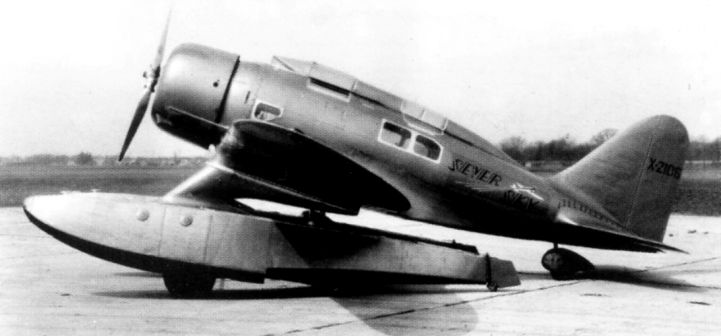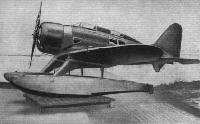
Варианты
- Seversky - SEV-3 - 1933 - США
- Seversky - SEV-2XP / BT-8 - 1934 - США
Seversky SEV-3
SEV-3 - первый самолет, созданный компанией "Seversky Aircraft Corporation", основанной в 1931 году бывшим россиянином Александром Николаевичем де Северским.
Исходный вариант представлял собою трехместную цельнометаллическую амфибию-низкоплан с мотором воздушного охлаждения Wright J-6 Whirlwind мощностью 420 л. с. Расположенные тандемом кабины летчика и двух пассажиров закрывались сдвижными фонарями.
Колеса шасси убирались в два главных поплавка с помощью гидравлики. При посадке на аэродром основные поплавки расконтривались и опускались под собственным весом задними частями вниз, чтобы расположенные на концах небольшие колеса коснулись земли раньше, чем основные колеса.
Прототип SEV-3 выполнил первый полет в июне 1933 года, в том же году на нем был установлен мировой рекорд скорости для амфибий с поршневыми моторами. Амфибия строилась небольшой серией только на экспорт. 15 сентября 1935 года на SEV-3M-WW с мотором Wright Cyclone мощностью 710 л. с. был установлен новый мировой рекорд скорости - 370,814 км/ч.
Описание:
- Seversky SEV-3
- Flight, November 1933
FAST AMERICAN AMPHIBIANS
Фотографии
-
Мировая Авиация 232
Регистрационный номер: X2106 [4] Первый самолет Северского - SEV-3XAR. Изначально его построили как амфибию, но потом доработали в самолет только аэродромного базирования. Чистота обводов самолета поражает даже сегодня.
-
Flight 1933-11 / Flight
A HIGH-SPEED AMPHIBIAN: An interesting machine designed by Maj. A. Seversky and constructed in New York. The twin duralumin floats contain retractable wheels and when the latter are extended the stern of each float is raised. With a 420-h.p. Wright "Whirlwind" it has an estimated speed of 190 m.p.h. as amphibian or 235 m.p.h. as landplane only. With supercharged 700-h.p. "Cyclone" a speed of 245 m.p.h. is expected as amphibian, or 290 m.p.h. as landplane.
-
Flight 1935-11 / Flight
The Seversky amphibian was designed expressly for its job. Its wheels are housed in the floats when retracted.
-
Aeroplane Monthly 1993-12 / H.Levy - Seversky (1)
The 3XAR amphibian, powered by a 420 h.p. Wright Whirlwind, was built at the College Point, New York, factory of the Edo float company in 1933. It was de Seversky’s first American design, and the first aeroplane to employ an all-metal, stressed-skin cantilever wing. Its unique Edo amphibious undercarriage had floats which could be pivoted up and down hydraulically for sea- or land-based operations, and the wheels were supported directly from the wing, independent of the floats. The pilot was seated forward, with room for two passengers in the rear cockpit. De Seversky established an amphibian world speed record of 188 m.p.h. with the SEV-3 in 1933. Spanning 36ft, it had a 1,640ft/min rate of climb and a service ceiling of 20,000ft.
-
Flight 1935-11 / Flight
Регистрационный номер: X2106 [4] APTLY NAMED: This is the Seversky amphibian which, fitted with a Wright Cyclone nine-cylinder radial of 750 h.p., recently broke the world's speed record for machines in its class with a speed of 230.03 m.p.h. The fastest lap of the course was made at 236 m.p.h. At the controls was the designer of the machine, Major Alexander de Seversky, who is seen in this photograph. He was accompanied on the record flight by his spaniel.
-
Aeroplane Monthly 1993-12 / H.Levy - Seversky (1)
The prototype in its amphibian form at North Beach Airport after a 750 h.p. Wright Cyclone had been installed. It set a new amphibian speed record of 230-413 m.p.h. in 1935, and set eight more world speed records in 1936 and ’37.
-
Aeroplane Monthly 1993-12 / H.Levy - Seversky (1)
The prototype in its landplane form at North Beach Airport after a 750 h.p. Wright Cyclone had been installed.
-
Aeroplane Monthly 1993-12 / H.Levy - Seversky (1)
Регистрационный номер: X2106 [4] The original 3AXR in landplane configuration with large undercarriage trousers and a streamlined tailwheel fairing.
-
Flight 1935-02 / Flight
200 M.P.H.TRAINERS: The widespread adoption of high-speed monoplanes in the U.S.A. has, it would appear, necessitated the provision of special training equipment. Accordingly, the U.S. Army Air Corps has ordered 35 SEV-3XAR monoplanes of the type shown here. Fitted with a 400 h.p. Wright "Whirlwind," the machine has a maximum speed of 200 m.p.h. and the climb to 12,000 ft. occupies ten minutes.
-
Flight 1934-05 / Flight
OVER NEW YORK: Major Alexander P. de Seversky flies his latest type, which may yet be entered for the "MacRobertson."
-
Flight 1936-08 / Flight
Four Seversky models gathered together at Farmingdale, Long Island, U.S.A., illustrate the persistence of the family likeness. From left to right are the new amphibian two-seater fighter (three of these have already been delivered to the Colombian Government); a landplane version of the machine on which Major de Seversky, its designer, established the world's amphibian speed record with 230.03 m.p.h.; the 1,000 h.p. Twin-Wasp-powered fighter ordered in quantity by the U.S. Army Air Corps; and the basic trainer for the same service.
Другие самолёты на фотографии: Seversky P-35 - США - 1936Seversky SEV-2XP / BT-8 - США - 1934
-
Aeroplane Monthly 1993-12 / H.Levy - Seversky (1)
Three SEV-3M-WWs, powered by Wright Whirlwinds, were built for the Colombian Air Force, to operate from high-altitude fields and narrow rivers.
-
Jane's All the World Aircraft 1980 / Encyclopedia of Aviation - Aircraft A-Z - v5
Seversky SEV 3M-WW, three of which were bought by Colombia.
-
Flight 1939-03 / Flight
Регистрационный номер: X2106 [4] The American Armament Corporation has developed a 37 mm. shell-gun which has great destructive power. This Seversky wing demonstrates the effect of one of the shells. From left to right are the wing intact (showing the aiming mark); the point of entry; and the exit.
-
Flight 1933-11 / Flight
THE SEVERSKY SEV-3 : Plan, side and front elevations.
- Фотографии














